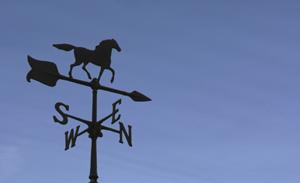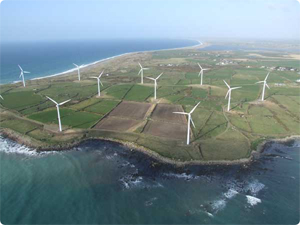Ireland's daring wind energy experiment
on
Ireland's daring wind energy experiment
Ireland is planning to take a giant leap in wind power capacity, propelling it to a leading position in Europe. The government wants to increase the share of wind power in the country's electricity production capacity to over 40%, more than double the current share. The problem is that these plans come at a time when demand has been falling as a result of the economic crisis, so that their realisation would lead to a huge overcapacity in the electricity market. The new government is beginning to show some signs of concern.
 |
| The coming of the new government may herald changes in energy policy as well |
The general elections that were held in Ireland on the 25th of February blew like a storm across the political landscape. Fianna Fáil, the Republican Party, which had been the largest party in Parliament since 1927, was blown away by angry voters, to be replaced by a coalition government of Labour and the centrist party Fine Gael. The reason for this historic change was of course the Irish debt crisis. But the coming of the new government may herald changes in energy policy as well. Buried deep in its coalition agreement ('Statement of Common Purpose') comes a promise that it 'will ensure that future wind farms are built in locations where the wind regime is best and that they will be built in large numbers or in clusters to reduce the cost of connection to the grid.' In future, says the coalition's Statement, wind energy will fall under a new 'plan-led' process 'as opposed to the existing developer-led system'.
This policy statement hardly means that Ireland is backing away from its policy of developing wind energy. But it is an indication that the new Government is concerned about its costs. As well it should be.
Ambitious
The previous government set the highly ambitious target to have the country produce 40% of its electricity from renewable sources by 2020 (this applies to both the Republic and Northern Ireland). The majority of this renewable supply is to be provided by wind energy. At this moment total electricity production capacity in Ireland is some 8570 MW, of which about 1400 MW consists of wind power (16%) and 240 MW consists of other forms of renewable energy, mainly small hydropower and a little bit of biomass. Wind farms supplied some 10.5% of electricity consumption in 2009.
The government's Commission for Energy Regulation (CER), the power sector's regulatory body, has produced two directives calling for an additional 3900 MW of new wind power capacity and an
| This build-up of wind energy comes at a very awkward time, when electricity demand has been falling as a result of the economic recession |
Assuming that such an expansion is possible, what will it mean in terms of reliability and costs? Well, there is good news and bad news for wind power advocates.
The good news on this front is that at 16.00 hours on 15th January, 2011, Ireland's wind power hit its highest ever output at 1,254 MW on line or 72% of total wind capacity. The bad news is that the record burst lasted only 12 hours and two days later output was running along at about 100 MW.
Some more bad news: the highest all-system demand spike so far in 2011 occurred at 17.45 hours on 5th January, when it reached 4,644 MW. Wind power's contribution to this was only 140 MW, or around 10% of its nameplate capacity. Indeed renewable energy's contribution to the Irish grid in January overall was 0.354 TWh out of a grand total of 2.55 TWh, or around 14% and this includes output from around 200 MW of hydro capacity.
Extraordinarily fast
OK, so everybody knows that wind energy is highly variable. This is, in fact, what makes the great Irish wind experiment so interesting. You could argue that sustaining a 1,254 MW output for as long as 12 hours is a major achievement, even if it did prompt jokes about the level of wind being almost as high as that coming from the politicians in the build-up to to the elections. A previous peak wind output on 26th December 2010 also lasted over 12 hours at above 1,150 MW, beating a previous record in August 2009 at 960 MW, which lasted barely two hours.
The contribution of wind energy to the Irish grid can thus be said to be consolidating, as it should be, for wind capacity has been growing extraordinarily fast. With hydrocapacity static at just above 200 MW, total renewable capacity has grown from just above 1,000 MW in January, 2008 to 1,741 MW in January 2011.
There is just one small problem, however. This build-up of wind energy comes at a very awkward time, when electricity demand has been falling as a result of the economic recession. Electricity demand fell by 5.35% in 2009 and it has continued down. Maximum load in January 2011 was some 300 MW below that of January 2010.
Back in 2005, Eirgrid was anticipating a peak winter demand of 5,517 MW by 2010. That was 400 MW
| Ireland is headed for a huge surplus production capacity. This seems senseless at first sight, but there is some sense in it |
Surplus capacity
So what has been happening in the good old fossil fuels power sector? ESB, the former state-owned monopoly supplier, which is now having to compete with independent producers, has built a new gas-fired CCGT (combined cycle gas turbine) power station at Aghada, whereas energy company Bord Gais has done the same in County Cork, amounting to a new combined capacity of 875 MW. In addition, due on line next year is the 500 MW capacity Irish-UK DC interconnector currently being constructed by ABB.
At the same time, ESB has promised to shut down several oil-fired power plants, although it has sold two of them to Endesa, which has plans to replace them with CCGT's. What it comes down to is that Ireland's conventional thermal plants are being replaced quite rapidly with high efficiency gas-fired capacity, but, all told, conventional thermal capacity is not being reduced very much at all and largely put back in the same geographical position as the old one.
 |
| Carnsore Wind Farm was the first wind farm completed on the east coast of Ireland in November 2002 (photo: Frank O'Brien) |
Thus, not only is Ireland rapidly expanding its wind energy capacity, it is also having to refurbish its old capacity by adding CCGTs and building new ones at the same time.
Extra cost
What will it all cost? That is the big unknown at the moment. Commercial sources put wind energy at roughly €2 million per MW. The total cost of the 2020 wind target at an additional 3,000 MW comes out at €6 billion. Meanwhile the Whitegate and Aghada CCGTs between them cost €767 million, while Endesa's two new gas plants can't fall much below €850 million.
What has to be added to this is the extra cost to the grid of reliably gathering in the power produced by a large number of widely distributed wind farms. The obvious problem here is that the bulk of the new wind capacity is on the other side of the country from the main areas of demand, most notably Dublin. Eirgrid’s development plan suggests that virtually every province of Ireland will require expansion of the grid, with an additional 1,100 km of new line and upgrading on 2,200 km. An early Eirgrid study - Grid 25 - put the cost of this at €4 billion.
It is a moot point as to whether the cost of the Ireland-UK interconnector at €600 million at should be added to this total. Wind power suffers from System Non-Synchronisation Penetration (SNSP), since it is much more difficult to keep a large number of wind turbines and wind farms in phase with its each other than large conventional plants. This is a subject of much dispute with the limit at which some
| The obvious problem here is that the bulk of the new wind capacity is on the other side of the country from the main areas of demand |
This is a core factor in the ability of electrical grids to absorb variable renewables or 'var-Res' as they have become in the jargon. In effect, with wider storage, smarter grids and interconnectors, wider distribution, better meteorological forecasting and in the end a sophisticated international market across Europe, the system should absorb not only the SNSP problem, but also the intermittency of var-Res in general. Nobody should however believe that the cost is equal to the capital expenditure on the wind turbines alone.
Savings
This is something that tends to be forgotten. The Irish Wind Energy Association (IWEA) has sponsored a new report on the impact of wind energy on pricing within the all-Ireland electricity market from Redpoint Energy. The analysis suggests that the typical domestic consumer will already save €5.40 in 2011 if there is high penetration of wind on the system. This will apparently rise to around €38 per consumer by. A joint study by Eirgrid and the Sustainable Energy Authority of Ireland is less optimistic. It suggests that the wholesale electricity price reduction through lower fuel use is roughly equivalent to the cost of the Public Service Obligation (PSO) of €52 million that is currently applied to wind power plus some other costs. This means that the transition to wind power would not cost the consumer any money, but would not lead to savings either.
The Redpoint study, however, concentrated only on electricity prices and the cost of renewable support, not on the capital expenditure on the grid or the new back-up capacity. Dr Michael Walsh, director of the IWEA believes from other studies that by 2020 the saving on fuel bills to the conventional power plant from free wind, put at €256 million, will still far outweigh the cost of both the grid renewal at €108 million annually and the PSO support at €52 million. This assumes that the PSO will not increase or that the costs to the grid have mostly been paid.
Case study
We shall see. Meanwhile the new coalition Government has also been busy with other energy policy suggestions. The state-owned Electricity Supply Board (ESB) is being transformed into the all-new and shiny "Electric Ireland" which could be a signal of its privatisation along with Bord Gais, the main gas
| Perhaps rather ominously for wind energy developers, there is the suggestion that only 'cost-effective projects' are to be supported by the renewable energy feed-in tariff |
Finally, and perhaps rather ominously for wind energy developers, there is the suggestion that only 'cost-effective projects' are to be supported by the renewable energy feed-in tariff and that this will 'be not significantly above' the all-Ireland market price for electricity, so the PSO appears to be under review.
It is not yet clear where all this will lead, but Ireland can be an interesting case study for other European countries. The country has recently been going further and faster in the development of wind energy than any other country in relation to the size of its system. How it proceeds with its high level of commitment to wind will have lessons for the rest of Europe, particularly its neighbour across the Irish Sea. Like Ireland, the UK has been experiencing a boom in wind energy, particularly of the more expensive offshore type and like Ireland it has a great deal of elderly conventional thermal plant coming up for renewal. The UK too may have to renew its conventional plant at the same time as it expands its wind and this will not be cheap.


Discussion (0 comments)